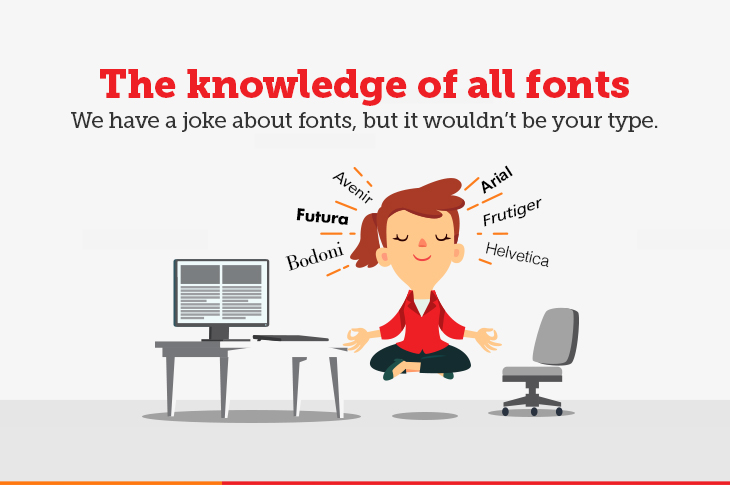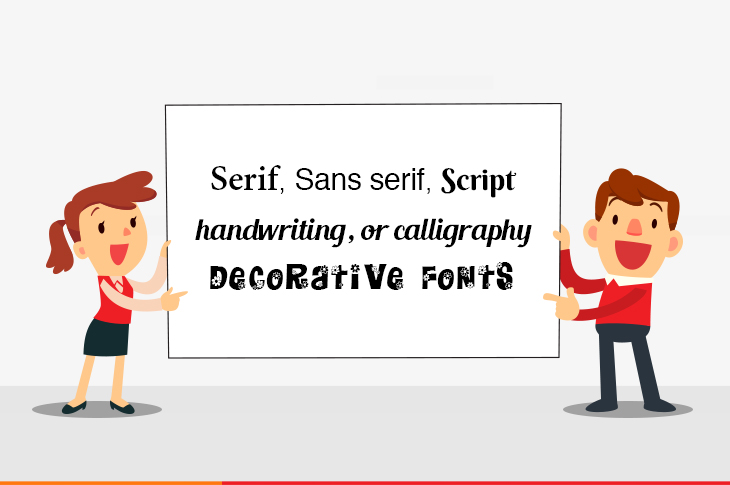Content Marketing Tip: How do I choose the best font

We have a joke about fonts, but it wouldn’t be your type.
This article won’t teach you everything about every single font, but we’re not the kind to shy away from a pun. What you will learn about in the paragraphs that follow are the basics of what influence fonts have on communication. After all, it’s not just what you write, it’s how you write it as well.
Let’s start with the basics: a font is much more than simply letters on a screen or printed page; it is the size of the letters, their shape, and sometimes even the colors used for the letters. Why are they important though? For this, we’ll have to go a little way back in history, to the invention of Apple’s first computer.
The influence of Steve Jobs
Steve Jobs was a freshman at Reed College when he enrolled for a calligraphy class taught by Robert Palladino, based purely on the eye-catching calligraphy he saw on flyers posted around the college campus. Interestingly, he went back there to attend Palladino’s classes even after he dropped out to found Apple.
We have Mr. Jobs to thank for the detail with which we examine fonts today – it is no accident that the fonts in the iOS ecosystem are different from what we’re used to. Apple was the first company to pay careful attention to typography because it realized that what the letters look like can also convey meaning or ideas, in much the same way body language helps one communicate without words.
Robert Palladino had other famous students as well, like Sumner Stone, who is famous for creating the ITC Stone font family. Interestingly, Palladino never used a computer during his entire life.
Font terminology 101

Before we go ahead and discuss fonts in detail, we need to learn a few basic terms about them first. ‘Serif’ family has those little strokes at the end of each letter that makes them look a little more elegant than if they weren’t there. There are also fonts without the little strokes at the ends, and they have been imaginatively christened ‘sans serif’. ‘Script’ fonts are those that mimic cursive handwriting or calligraphy. Finally, there are ‘decorative fonts’ that project a cute, artsy appeal.
Each style has a merit of its own. It is only after much deliberation that a certain style makes it to the brand style guide for a content marketing campaign.
Today there is a bewildering array of fonts at your disposal, and you must choose your font based on a number of things. Let’s look at some of them:
1. It must be readable.
If the words aren’t easily read, they defeat their purpose, which is communication. This must be the primary requirement. The font should not appear to make any words other than the ones intended by the client and the target audience should not struggle to read the words they spell out. Whether you’re choosing your style for a logo or for text on your website, or for any other collateral that you’re creating as part of your content marketing initiatives, this requirement does not change. Serif and sans serif fonts used for text are equally legible, but decorative fonts aren’t as easy to read, especially if they are used to make long paragraphs.
2. Improve readability by increasing font size and line spacing.
This might seem like an insignificant thing, but a larger font, with more space between the individual letters, makes the text easier to read (and avoids unintentional hilarity as in the MEGAFLICKS logo). Your clients won’t have to struggle to read between the lines!

3. What image do you want to convey?
A serif style will put you across as a more traditional venture; a sans serif font will pitch you as a modern, forward-thinking endeavor. Decorative fonts will surely make you stand out, but they aren’t easy to read, so they should be avoided for large blocks of text. Bold text will make you come across as strong, but you need to avoid coming on too strong as well.
4. Font choice is equally important when designing logos
Much of the same rules apply to logo fonts as well. So, use a serif to convey comfort, reliability, and respectability. A sans serif font will project stability and a progressive outlook A script-type style will lean towards comfort and tradition, while also throwing elegance and creativity into the mix. Decorative fonts are usually used for logos that need to appeal to the young (or simply the young at heart!) and grab attention immediately.
5. Your reader needs to have the font on their system
If your font needs to load from the reader’s system, it’s no good choosing the most awesome font in the history of calligraphy, only to have them get the message ‘this font isn’t available on your system’. You need to choose from the best that is widely available to deliver a great experience to your reader right off the bat.
6. Let your fonts contrast for better impact.
Use the styles that convey opposing things for headers and paragraphs, for example. However, don’t use fonts with overlapping characteristics, as they might send mixed messages. It’s okay if a single font style works for your entire presentation or website; you can add variety by using bold or italic words or sections.
7. Learn the rules – and then break them.
To be truly great at something, you need to learn the rules first, which is why you’re here at the end of this piece, trying to take in every last bit of information. Once you’re a veritable, er, ‘font’ of knowledge, start bending them to your will and surprise your client!
Words can paint a picture if used right – but careful selection of fonts can help convey much more than mere words ever could. From a content marketing perspective, you need to be as choosy about the styles you use in your content pieces as you are about their tone and messaging. Hopefully, this article can get you started down the rabbit hole of different fonts and how you can use them effectively in your communication.
Make managing content easier with Scatter Content Box! Designed with cutting edge technology, our purpose-built platform for marketers can make digital asset management seamless, maximizes collaboration between teams and enhances productivity. Ask for a demo to learn more.
Sources:
